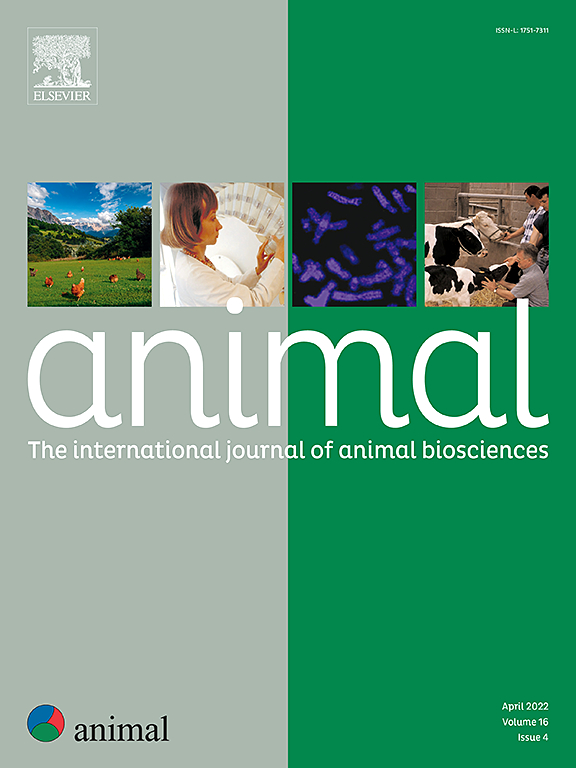在哺乳早期交叉寄养一头多余仔猪并混合产仔后的母猪和产仔性能
IF 4
2区 农林科学
Q1 AGRICULTURE, DAIRY & ANIMAL SCIENCE
引用次数: 0
摘要
活产仔猪的数量经常多于可使用的乳头数量,有些猪场用多余的仔猪来均衡产仔数,从而限制了仔猪接触乳房的机会。消除产仔箱之间的障碍可使仔猪与其他母猪交往并寻找其他母猪。因此,我们评估了交叉寄养和社会化对母猪和仔猪泌乳期生产性能的影响。在一个 2 × 2 的因子设计中包含了两个因素:社会化和交叉配种时相对于母猪功能性乳头数的窝仔猪数。然后将仔猪(n = 189)分配到四个组中的一组:CONT+0(不与其他仔猪混合)、CONT+1(不与其他仔猪混合)、Co-M+0(与其他仔猪混合)、Co-M+1(与其他仔猪混合)。仔猪出生后 12-16 小时内进行交叉寄养,24 小时后,拆除相邻两栏之间的隔离栏,对 Co-M 组进行社会化分群。在哺乳期,+1 组母猪比 +0 组母猪损失更多的卡尺单位(P = 0.04)。各组之间功能性乳头的数量没有差异,但断奶时,Co-M 组母猪的乳房损伤评分高于 CONT 组(6.55 vs 4.83;P < 0.01)。此外,+1 母猪在整个哺乳期空置乳头较少(P < 0.01)。各组之间的产奶量没有差异(P ≥ 0.13)。在断奶仔猪数方面,没有观察到社会化方面的差异(P = 0.84),但 + 1 母猪比 + 0 多断奶 0.67 头仔猪(P < 0.01)。虽然断奶时 CONT+0 的仔猪最重(P <0.01),但各组间的窝重没有差异(P ≥ 0.08)。与 CONT 组相比,Co-M 组经常出现面部和关节病变(P < 0.01)。不同处理的仔猪损失率没有差异(总损失率 = 12.6%;P ≥ 0.26)。但是,+1 仔猪的淘汰率高于+0(P < 0.01)。因饥饿而死亡的情况在 CONT+1 中比在 CONT+0 中高(P < 0.01),但在 Co-M 组间没有差异(P = 0.99)。相对于功能性乳头数多一头仔猪的窝,断奶仔猪数较多,但个体体重较轻。仔猪社会化可减轻高产仔数的影响,但断奶仔猪乳房损伤、面部和关节损伤的比例更高。本文章由计算机程序翻译,如有差异,请以英文原文为准。
Sow and litter performance after cross-fostering one surplus piglet and co-mingling the litters at early lactation
The number of piglets born alive is frequently greater than the functional teats, and some farms are equalizing litters with surplus piglets, limiting piglet udder access. Removing the barrier among farrowing crates may allow piglets to socialize and seek other sows. Thus, we evaluated the effects litter size at cross-fostering and socialization on the sow and piglet performance during lactation. Two factors were included in a 2 × 2 factorial design: socialization and litter size relative to sow functional teat number at cross-fostering. Litters (n = 189) were then assigned to one of four groups: CONT+0 (litters not co-mingled with no additional piglet), CONT+1 (not co-mingled with one additional piglet), Co-M+0 (co-mingled with no additional piglet), Co-M+1 (co-mingled with one additional piglet). Piglets were cross-fostered from 12–16 h after birth, and 24 h later, Co-M groups were socialized by removing the barrier between two adjacent pens. During lactation, sows lost more caliper units in the + 1 group than in the + 0 group (P = 0.04). The number of functional teats did not differ among groups, but Co-M sows had a higher udder lesion score at weaning than CONT (6.55 vs 4.83; P < 0.01). Furthermore, +1 sows had fewer vacant teats throughout lactation (P < 0.01). Milk yield did not differ among the groups (P ≥ 0.13). Regarding the number of weaned piglets, no difference was observed for socialization (P = 0.84), but + 1 sows weaned 0.67 more piglets than + 0 (P < 0.01). Although CONT+0 had the heaviest piglets at weaning (P < 0.01), litter weight did not differ among the groups (P ≥ 0.08). Facial and joint lesions were frequently observed in Co-M (P < 0.01) than CONT. Piglet loss rate did not differ among treatments (overall rate = 12.6%; P ≥ 0.26). The removal rate, however, was more frequent in + 1 litters than in + 0 (P < 0.01). Death due to starvation was higher in CONT+1 than CONT+0 (P < 0.01) but did not differ between the Co-M groups (P = 0.99). Litters formed with one additional piglet relative to functional teat number weaned more piglets, albeit with lower individual weight. Litter socialization may alleviate the impact of high litter size but shows greater percentages of udder injuries and facial and joint lesions in weaned piglets.
求助全文
通过发布文献求助,成功后即可免费获取论文全文。
去求助
来源期刊

Animal
农林科学-奶制品与动物科学
CiteScore
7.50
自引率
2.80%
发文量
246
审稿时长
3 months
期刊介绍:
Editorial board
animal attracts the best research in animal biology and animal systems from across the spectrum of the agricultural, biomedical, and environmental sciences. It is the central element in an exciting collaboration between the British Society of Animal Science (BSAS), Institut National de la Recherche Agronomique (INRA) and the European Federation of Animal Science (EAAP) and represents a merging of three scientific journals: Animal Science; Animal Research; Reproduction, Nutrition, Development. animal publishes original cutting-edge research, ''hot'' topics and horizon-scanning reviews on animal-related aspects of the life sciences at the molecular, cellular, organ, whole animal and production system levels. The main subject areas include: breeding and genetics; nutrition; physiology and functional biology of systems; behaviour, health and welfare; farming systems, environmental impact and climate change; product quality, human health and well-being. Animal models and papers dealing with the integration of research between these topics and their impact on the environment and people are particularly welcome.
 求助内容:
求助内容: 应助结果提醒方式:
应助结果提醒方式:


